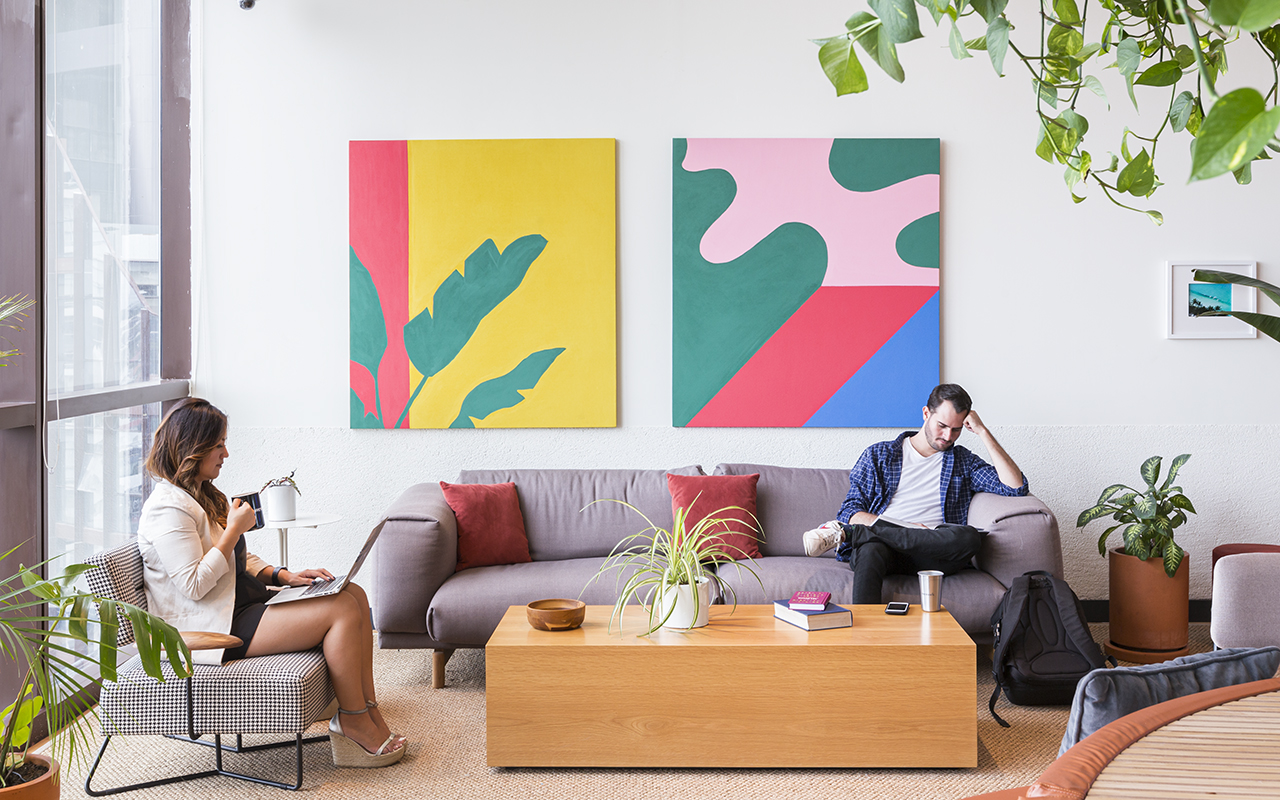Space is a powerful tool to foster engagement, inspire innovation, and drive productivity. But what exactly does an optimal space look like? In the Science of Space, we explore how the science of intentional design can turn any work environment into a holistic experience.
Interpersonal space, or the amount of physical space between people, tells us a lot about our environments and culture. As we return to the office in a socially distanced way, we’ll have to renegotiate our understanding of personal space—both our own and our space in relation to others.
The study of interpersonal space is known as proxemics. One important aspect of it is that it’s nonverbal. We don’t go around asking strangers if we can pass them; we judge from their body language how to best maneuver through their space as necessary.
As we return to the workplace, the office environment will be filled with cues on how to maintain safe distances between coworkers. But the six-feet-apart recommendation is only a benchmark. The degree of space each employee needs to feel safe in the office will vary greatly.
The fact that proxemics are personal and nonverbal makes the experience of being in the office during the coronavirus pandemic particularly difficult to manage. We’ve experienced sudden, radical shifts in our proxemic norms, and we will need to reimagine the way we negotiate proxemics with our colleagues.
What is proxemics?
Classical proxemics theory was started in the 1960s by anthropologist Edward T. Hall. He classified four degrees of interpersonal distance, or degrees of proximity that we experience:
1. Public distance
At this distance (between 12–25 feet), you must speak louder to be heard, and it’s more difficult to maintain direct eye contact, so the connection between two people is minimal.
2. Social distance
This distance (between 4–12 feet) relies on visual and auditory cues to form a connection, since you’re still too far apart to touch or perceive body heat.
3. Personal distance
This distance (between 1.5–4 feet) is kept during interactions with friends. Here, vision is clear, eye contact is strong, and conversation flows easily.
4. Intimate distance
At this distance (0–1.5 feet), the aura of a person forms a stronger sense of connection than visual or auditory cues. Body heat and olfactory senses add to the connection.
The study of proxemics is important because we need proximity to form bonds and communicate effectively. Many would say proximity is essential for mental health. In managing the distance between ourselves and others, we control the level of exposure to another person that we’re comfortable experiencing. For example, we might stand close and touch our friends while talking but stand back and maintain eye contact with an instructor after a lecture. If a stranger stands too close to us, we might react negatively and perceive it as an intrusion into our personal space. One interaction between two people can move from a public one to an intimate one in the span of five feet of space—and that possibility can cause a lot of anxiety.
A sudden change in interpersonal space
Over the past four months, proxemics has changed drastically. We have all become dramatically aware of a new benchmark in interpersonal space: the new social distance necessary to slow the spread of COVID-19. The six feet distance recommended by the Centers for Disease Control has become the norm in the U.S. and has impacted every corner of our public spaces, from parks to grocery stores.
We have also experienced a global quarantine that forced us to adopt new proximities that seem to be either radically close in the case of many nuclear families, or radically distant in the case of many who live alone. Either way, the experience has been a private one, specific to each person, and the media has been flooded with stories of people trying to cope with these boundaries.
In the physical workplace, in-person interactions can increase productivity. Communication can flow easier when teammates meet face-to-face, and relationships can be forged, which create positive culture within organizations. Physical proximity makes it more likely that people will become friends—people feel a stronger connection to those they are physically close to. Learning through observing people at work also occurs through these interactions.
But navigating proxemics as we return to our workplaces during COVID-19 will necessitate a little more conversation with our colleagues.
How to respect personal space in the workplace during COVID-19
Although proxemics is known to be nonverbal, it’s now important to ask your colleague if they’re comfortable with the degree of interpersonal space you’re providing. Alternately, you need to feel empowered to name the degree of proximity you, yourself, need in order to be comfortable.
Team leaders can discuss with each team member the degree of proximity that’s right for them. Having an open and honest conversation about proxemics will both alleviate the stress of potentially intruding on someone’s safe space and having your own safe space intruded upon.
Teams could also devise creative solutions that help foster in-person collaboration while maintaining a comfortable proximity. For some teams, the right solution may be having extra sanitation stations near them, and to agree on how frequently everyone wipes down surfaces after using them. For others it might be structuring times of proximity into the workday. Close collaboration might happen just once daily during stand-ups, after which the team works separately for the remaining working hours.
Global heads of business should consider how to roll out these conversations at scale. The important point is that proximity is personal. One corporate policy will not fit all. Instead, the corporate practice of “ask first” will benefit all team members, giving them the agency they need to feel safe and rebuild their work styles.
Workplace culture will be enhanced only if we practice accommodating differences in proximity. As we return to the office amid the pandemic, we should strive to become more aware of our differences and work to build a more inclusive culture. The practice of including proxemics into corporate norms and team work styles not only benefits those concerned with a potential viral transmission. It will be a step forward in accommodating many other differences in our workplaces so that they become more diverse, vibrant, and productive.
Ashley Bryan is a senior strategist at WeWork. As part of the customer marketing and technology team, she focuses on audience insights and customer segmentation, drawing connections between member attributes and their experiences. Bryan has a background in architecture and brand strategy, with eight years of agency experience at firms in New York City and San Francisco.
Rethinking your workspace?








